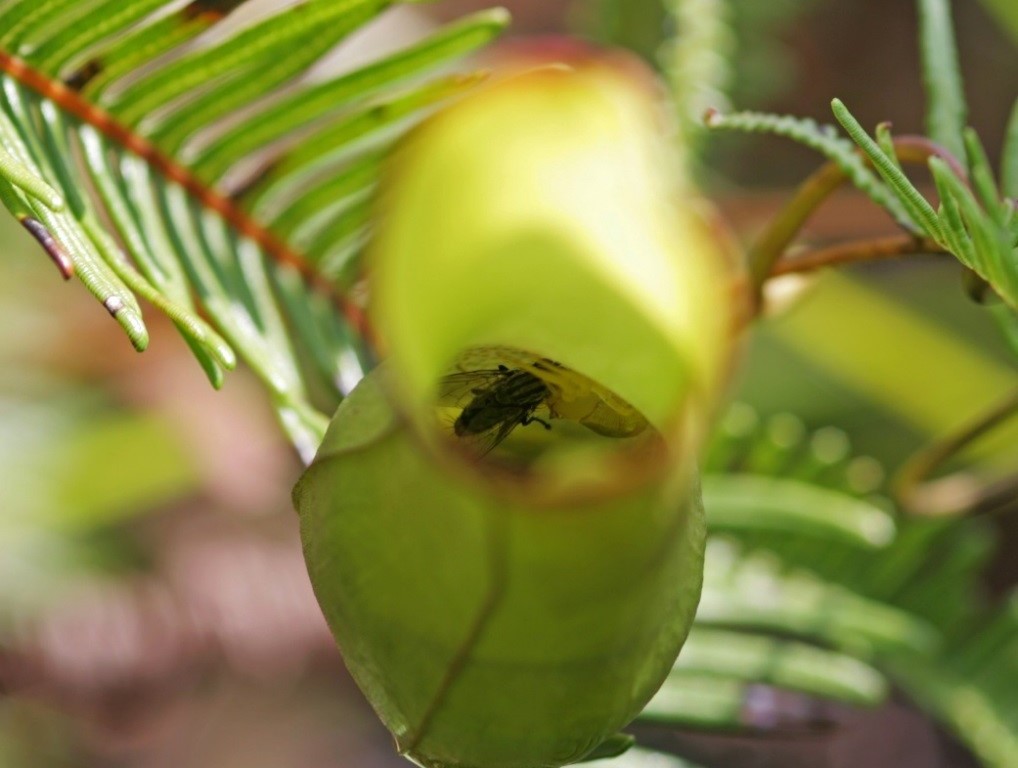The carnivorous traps of Nepenthes pitcher plants are sometimes inhabited by a species of crab spider which ambushes insects as they arrive at traps. Recently published work by Weng Ngai Lam and Hugh Tan showed that this apparent thievery is actually beneficial to the plants — but only when crab spiders attack big prey with high nutrient contents.
Pitcher plants are carnivorous plants that trap and digest insect prey to supplement their nutrient requirements. But some specialized animals are able to exploit their traps and make a living out of these modified leaf structures. One such animal is the pitcher crab spider (Thomisus nepenthiphilus), which lives in pitchers of the slender pitcher plant (Nepenthes gracilis). This crab spider spends its whole life in pitchers, building its nests on pitcher walls, and diving into its fluids to hide whenever it senses danger from without.

Pitchers secrete nectar around their lids and lips (also known as ‘peristomes’), and visiting insects often slip into their fluids while feeding on this nectar. Slender pitcher plants trap lots of ants this way, but only succeed in trapping flying insect prey occasionally. In an earlier, experimental study, we had shown that the pitcher crab spider ambushes flesh flies as these are feeding at pitchers, and subsequently drops prey carcasses into pitcher fluids after feeding on them. Fortunately, flesh fly carcasses still contain some nutrients after being consumed by crab spiders, and pitchers can benefit from this residual nitrogen. Thus, pitchers which are not inhabited by crab spiders catch fewer prey, but get more out of each, while those which are inhabited ‘catch’ more, but get less out of each.

In our recently published article in the Journal of Animal Ecology, we examined the natural prey spectra of pitchers which were inhabited or uninhabited by crab spiders, and identified a few prey taxa which were ‘trapped’ in higher numbers in crab spider-inhabited ones. We then measured the nutrient contents of these prey and estimated the nutritional benefit that pitchers would obtain from crab spiders’ consumption of them.
We found that crab spiders increased the prey capture rates of multiple different prey taxa, including mosquitoes, scuttle flies, flesh flies, cockroaches, bean bugs, and even other spiders. Unsurprisingly, small prey were trapped in greater abundances, both by pitchers alone, and by crab spiders inhabiting them, while large prey were only trapped occasionally. However, crab spiders’ contributions to pitchers were much higher through large prey like bean bugs and cockroaches than they were through small prey like mosquitoes and scuttle flies.

Reviewing the literature on nutritional mutualisms, we classified this interaction as a ‘resource conversion’ mutualism—an interspecific interaction in which one species (in this case the crab spider) converts a resource from a poorly-accessible state (flying prey which pitchers seldom trap) to a more accessible one (prey carcasses deposited straight into pitcher fluids) for its partner (the pitcher plant), often in exchange for a non-resource benefit such as protection or domicile. Our study confirms the existence of mutualism between the slender pitcher plant and the pitcher crab spider. But it also shows that this relationship, like many other resource conversion mutualisms, can have both beneficial or harmful net effects on the host species, depending on the quality (in this case prey nutrient content) of the resource being converted. It seems, from the perspective of the pitcher plant, that crab spider tenants should either go big or go home.
More Info:
Lim, R.J.Y, Lam, W.N., and Tan, H.T.W. (2018) Novel pitcher plant–spider mutualism is dependent upon environmental resource abundance. Oecologia.
Lam, W.N., and Tan, H.T.W. (2018) The crab spider–pitcher plant relationship is a nutritional mutualism that is dependent on prey resource quality. Journal of Animal Ecology.

2 thoughts on “Go Big or Go Home: Pitcher plant hosts and their crab spider tenants”